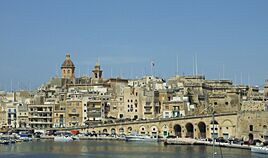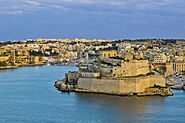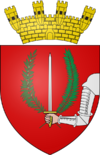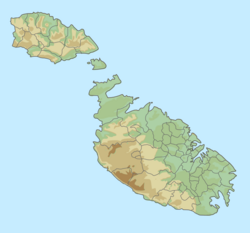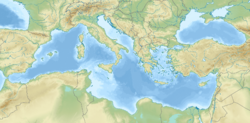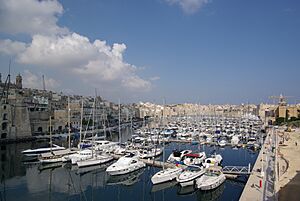Birgu facts for kids
Quick facts for kids
Birgu
Il-Birgu
Città Vittoriosa
|
|||
|---|---|---|---|
|
City and Local council
|
|||
|
From top: skyline, Fort Saint Angelo, Auberge d'Angleterre, Advanced Gate, Malta Maritime Museum, Church of St. Lawrence
|
|||
|
|||
| Country | |||
| Region | South Eastern Region | ||
| District | Southern Harbour District | ||
| Borders | Cospicua, Kalkara, Żabbar | ||
| Area | |||
| • Total | 0.5 km2 (0.2 sq mi) | ||
| Population
(Jan. 2019)
|
|||
| • Total | 2,489 | ||
| • Density | 5,000/km2 (12,900/sq mi) | ||
| Demonym(s) | Ġirbi (m), Ġirbija (f), Ġirbin (pl) | ||
| Time zone | UTC+1 (CET) | ||
| • Summer (DST) | UTC+2 (CEST) | ||
| Postal code |
BRG
|
||
| Dialing code | 356 | ||
| ISO 3166 code | MT-03 | ||
| Patron saint | St. Lawrence | ||
| Day of festa | 10 August | ||
Birgu (also called Il-Birgu in Maltese or Vittoriosa in Italian) is an old, fortified city in Malta. It's also known as Città Vittoriosa, which means 'Victorious City'. This historic city is located on the south side of the Grand Harbour in Malta.
Birgu sits on a piece of land that sticks out into the water. At its tip is Fort Saint Angelo, and at its base is the city of Cospicua. Because of its great location, Birgu has always been a safe place for ships. This has given it a long history with sea activities, trade, and military events.
Birgu is very old, dating back to medieval times. Before Valletta became the capital of Malta, Birgu was super important. Any military power wanting to control Malta needed to control Birgu first. From 1530 to 1571, it was the main base and unofficial capital for the Order of Saint John. Birgu is especially famous for its key role in the Great Siege of Malta in 1565.
In the early 1900s, Birgu had over 6,000 people. This number has gone down over the years. In 2014, about 2,629 people lived there. Many locals speak a special dialect called the Cottonera Dialect.
Contents
Discovering Birgu's Past
Many different groups helped shape Birgu over time. These included the Phoenicians, Greeks, Romans, Byzantines, Arabs, Normans, and Aragonese. Later, the Order of Saint John also played a huge role.
Birgu was once part of a larger area called Birmula. When the Order of St John arrived in Malta, they planned to build three cities from this land. These were Senglea, Vittoriosa (Birgu), and Cospicua. The rest of the land was named Cottonera. It was surrounded by strong walls called the Cottonera lines.
In the Middle Ages, some people in Birgu didn't want to pay taxes to the main town council in Mdina. They felt they were part of the Castrum Maris (which became Fort St. Angelo) area, which was separate.
Birgu as the Knights' Capital
After being forced out of Rhodes by the Ottoman Empire, the Order of Saint John were given Malta as their new home. In 1526, they sent knights to check out Malta. They found Birgu to be a small, unprotected town. But when they arrived in 1530, they chose Birgu as their capital. This was because the old capital, Mdina, was inland. Birgu's location by the sea was perfect for their navy.
The city was made stronger with new defenses in the 1530s. More improvements were added in the 1550s. This was to get ready for an attack from the Ottoman Empire. A large fort, the Castle of St Angelo, was built. It was separated from the city by a small water channel. A drawbridge connected the castle to the city.
The Great Siege and Victory
Birgu was the site of major battles during the Great Siege of Malta in 1565. The Knights and the Ottoman Empire fought fiercely for four months. In August, the Ottoman army almost captured the city. But the Knights, led by Grand Master Jean Parisot de Valette, fought back and took it again. A month later, more help arrived from Sicily. The Ottomans then gave up the siege.
After this great victory, a new capital city was built. It was named Valletta after the Grand Master. In 1571, the Knights moved their main base to Valletta. Birgu became less important, but it gained a special title. It was called Città Vittoriosa, which means "victorious city" in Italian.
Later History and World War II
In 1798, Napoleon took over Malta, and French soldiers were stationed in Birgu. Soon, the Maltese people rebelled. They, with help from Britain, Portugal, and Naples, blocked the Grand Harbour area. The French finally gave up in 1800. Malta then became a British protectorate. The British Royal Navy made Birgu its main base. British forces stayed in Birgu until 1979.
In 1806, a gunpowder storage building in Birgu exploded. This sad event killed over 200 people.
Birgu was heavily bombed during World War II. This was because it was very close to the Malta Dockyard. Many old buildings were destroyed, like the Birgu Clock Tower.
In recent years, the Sovereign Military Order of Malta has returned to the island. They now have special use of Fort St. Angelo in Birgu. This agreement will last for 99 years.
Exploring Birgu's Attractions
Birgu has many interesting places to visit. The historic Vittoriosa Waterfront has old buildings. These include the former Palace of the General of the Galleys and the Knights of St John's treasury. This area was updated in the early 2000s. The old palace is now a casino. The treasury building is home to the Malta Maritime Museum. Another museum, the Vittoriosa 1565 Museum, is also in town. It tells the story of the 1565 siege and battle.
St. Lawrence's Church is one of several churches in Birgu. It used to be the main church for the Order of St John. It is dedicated to St. Lawrence of Rome. The feast day for St. Lawrence is very popular with locals. Celebrations start on July 31 and last until August 10, the saint's feast day.
Other churches in Birgu include the Monastery of St. Scholastica. There is also the Our Lady of Annunciation Church, run by the Dominican Order. This church is also known as St. Dominic's Church. The feast of Saint Dominic is held every last Sunday of August.
The Freedom Monument remembers when British forces left the island in 1979. Birgu also has five Auberges of the Knights. These were like inns or homes for knights from different countries. One of them, the Auberge d'Angleterre, was home to the English Knights. It now has a public library.
At the center of the Grand Harbour, the 16th-century Fort St Angelo still stands. It is currently being restored. The main square in Birgu was badly damaged during World War II bombings. However, one 19th-century palace survived. It is now the headquarters of the St Lawrence Band Club.
Birgu's Population Over Time
In 1901, Birgu had 6,093 people. This number grew slightly to 6,673 by 1931. However, after World War II, the population dropped to 3,816 in 1948. It increased a little by 1957. Since then, the city's population has generally decreased. In March 2014, it was 2,629.
Famous People from Birgu
Many important people were born in Birgu:
- The architects and engineers Girolamo Cassar, his brother Andrew Cassar, and his son Vittorio Cassar were all born here in the 1500s.
- Architect Lorenzo Gafà (1638–1703) was also born in Birgu. He designed many churches in Malta, including St. Paul's Cathedral in Mdina.
- Paul Boffa (1890–1962) was born in the city. He was the Prime Minister of Malta from 1947 to 1950. He was also the country's first Prime Minister from the Labour Party.
- Sr. Beniamina Portelli, who founded and directed the St. Monica Choir, was born in Birgu.
- Prospero Grech (1925–2019) was a friar who helped start a special institute in Rome. He was made a cardinal in 2012.
Honorary Citizens
Some people have been given the special title of honorary citizenship of Birgu:
| Date | Name | Notes |
|---|---|---|
| 27 April 2003 | Andrew Bertie | 78th Grand Master of the Knights Hospitaller from 1988-2008. |
| 15 April 2015 | Matthew Festing | 79th Grand Master of the Knights Hospitaller from 2008-2017. |
Birgu's Sister City
Birgu is twinned with:
Birgu in Stories
The novel The Disorderly Knights by Dorothy Dunnett features events in Birgu. This book is part of her Lymond Chronicles series. It covers what happened in Birgu in 1551, including the Dragut Raid.
Areas within Birgu
- Bighi Sally Port
- Couvre Porte
- It-Toqba tal-Birgu
- Post is-Sagra Infirmerija
- Xatt Tal-Birgu
- Xatt il-Forn
- Xatt ir-Risq
- Xatt iż-Żejt
- Xatt Sant' Anġlu
See also
 In Spanish: Birgu para niños
In Spanish: Birgu para niños


